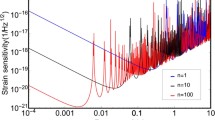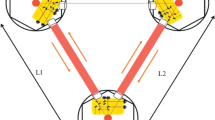Abstract
The space-based gravitational wave detectors at low frequencies has received great attention recently. Due to lack of considering the relative motion between spacecrafts, the accuracy of current sensitivity models is inadequate for space-based gravitational wave detectors. In this paper, an accurate sensitivity model of the space-based gravitational wave detector is established by taking into account the relative motion between two spacecrafts. The accurate sensitivity model is derived by employing a gravitational wave perturbed metric tensor. Then, to minimize the sensitivity loss due to the solar radiation, an enhancement strategy is proposed. Finally, simulation studies are presented with two drag-free spacecrafts in Earth’s orbit. Simulation results validate the effectiveness of the proposed strategy.


















Similar content being viewed by others
References
Abbott, B.P., Abbott, R., Abbott, T.D., Abernathy, M.R., Acernese, F., et al.: Observation of gravitational waves from a binary black hole merger. Phys. Rev. Lett. 116(6), 061102 (2016)
Abbott, B.P., Abbott, R., Abbott, T.D., Acernese, F., Ackley, K., et al.: GW170814: a three-detector observation of gravitational waves from a binary black hole coalescence. Phys. Rev. Lett. 119(14), 141101 (2017)
Amaro-Seoane, P., Aoudia, S., Babak, S., Binétruy, P., Berti, E., et al.: eLISA: Astrophysics and cosmology in the millihertz regime. arXiv preprint arXiv. 1201.3621 (2012)
Amaro-Seoane, P., Aoudia, S., Babak, S., Binétruy, P., Berti, E., et al.: eLISA: Astrophysics and cosmology in the millihertz regime. Journal of Neuroscience Research. 67(3), 337–345 (2012)
Brewer, S.M., Chen, J.S., Hankin, A.M., Clements, E.R., Chou, C.W., et al.: Al+ 27 quantum-logic clock with a systematic uncertainty below 10−18. Phys. Rev. Lett. 123(3), 033201 (2019)
Cui, K., Liu, H., Jiang, W., Yu, D.: Effects of Thrust Noise and Measurement Noise on Drag-Free and Attitude Control System. Microgravity Sci. Technol. 32(2), 189–202 (2019)
Fichter, W., Schleicher, A., Bennani, S., Wu, S.: Wu, Closed loop performance and limitations of the LISA Pathfinder drag-free control system. AIAA 2007-6732, AIAA Guidance Navigation and Control Conference, 20–23 August 2007, Hilton Head, South Carolina
Hu, X.C., Li, X.H., Wang, Y., Feng, W.F., Zhou, M.Y., et al.: Fundamentals of the orbit and response for TianQin. Classical. Quantum Gravity. 35(9), 095008 (2018)
Kaufmann, W.J.: Redshift fluctuations arising from gravitational waves. Nature. 227(5254), 157–158 (1970)
Kolkowitz, S., Pikovski, I., Langellier, N., Lukin, M.D., Walsworth, R.L., et al.: Gravitational wave detection with optical lattice atomic clocks. Physical Review D. 94(12), 124043 (2016)
Larson, S.L., Hiscock, W.A., Hellings, R.W.: Sensitivity curves for spaceborne gravitational wave interferometers. Physical Review D. 62(6), 062001 (2000)
Larson, S.L., Hellings, R.W., Hiscock, W.A.: Unequal arm space-borne gravitational wave detectors. Physical Review D. 66(6), 062001 (2002)
Li, Y., Wang, C., Wang, L., Liu, H., Jin G.: A Laser Interferometer Prototype with Pico-Meter Measurement Precision for Taiji Space Gravitational Wave Detection Mission in China. Microgravity Sci. Technol. 32(3), 331–338 (2020)
Liang, D., Gong, Y., Weinstein, A.J., Zhang, C., Zhang, C.: Frequency response of space-based interferometric gravitational-wave detectors. Physical Review D. 99(10), 104027 (2019)
Liu, H., Luo, Z., Jin, G.: The development of phasemeter for Taiji space gravitational wave detection. Microgravity Sci. Technol. 30(6), 775–781 (2018)
Lu, X.Y., Tan, Y.J., Shao, C.G.: Sensitivity functions for space-borne gravitational wave detectors. Physical Review D. 100(4), 044042 (2019)
Luo, J., Chen, L.S., Duan, H.Z., Gong, Y.G., Hu, S.C., et al.: TianQin: a space-borne gravitational wave detector. Classical. Quantum Gravity. 33(3), 035010 (2016)
Nelson, R.A.: Relativistic time transfer in the vicinity of the earth and in the solar system. Metrologia. 48(4), S171 (2011)
Oelker, E., Hutson, R.B., Kennedy, C. J., Sonderhouse, L., Bothwell, T., et al.: Demonstration of 4.8×10-17 stability at 1 s for two independent optical clocks. Nature Photonics. 13(10), 714–719 (2019)
Petit, G., Wolf, P.: Relativistic theory for time comparisons: a review. Metrologia. 42(3), S138 (2005)
Piran, T., Reiter, E., Unruh, W.G., Vessot, R.F.C.: Filtering of spacecraft Doppler tracking data and detection of gravitational radiation. Physical Review D. 34(4), 984 (1986)
Qin, C.G., Shao, C.G.: General post-Minkowskian expansion and application of the phase function. Physical Review D. 96(2), 024003 (2017)
Schrijver, C.J., Beer, J., Baltensperger, U., Cliver E.W., Güdel, M., et al.: Estimating the frequency of extremely energetic solar events, based on solar, stellar, lunar, and terrestrial records. Journal of Geophysical Research: Space Physics. 117, (A08103) (2012)
Stroeer, A., Vecchio, A.: The LISA verification binaries. Classical. Quantum Gravity. 23(19), S809 (2006)
Su, J., Wang, Q., Wang, Q., Wang, Q., Jetzer, P.: Low-frequency gravitational wave detection via double optical clocks in space. Classical. Quantum Gravity. 35(8), 085010 (2018)
Turyshev, S.G., Yu, N., Toth, V.T.: General relativistic observables for the ACES experiment. Physical Review D. 93(4), 045027 (2016)
Vutha, A.: Optical frequency standards for gravitational wave detection using spacecraft Doppler velocimetry. New J. Phys. 17(6), 063030 (2015)
Wu, F.F., Tang, Y.B., Shi, T.Y., Tang, L.Y.: Magic-intensity trapping of the mg lattice clock with light shift suppressed below 10−19. Phys. Rev. A. 101(5), 053414 (2020)
Zeng, G., Wu, X.L., Gong, B., Li, D.L., Wang, C.: Analysis of influence of solar radiation pressure on ground track keeping controlling zero yaw attitude mode. Chin. Space Sci. Technol. 39(3), 23–29 (in Chinese) (2019)
Zhang, C., He, J., Duan, L., Kang, Q.: Design of an Active Disturbance Rejection Control for drag-free satellite. Microgravity Sci. Technol. 31(1), 31–48 (2019)
Zhou, J., Liu, L., Wang, Z.: Modeling and analysis of ultra-low frequency dynamics of drag-free satellites. Microgravity Sci. Technol. 31(2), 151–160 (2019)
Acknowledgements
This work is supported by the National Natural Science Foundation of China (51675430 and 11402044).
Author information
Authors and Affiliations
Corresponding author
Ethics declarations
Conflict of Interest
No competing financial interests exist.
Additional information
Publisher’s Note
Springer Nature remains neutral with regard to jurisdictional claims in published maps and institutional affiliations.
Rights and permissions
About this article
Cite this article
Liang, J., Liu, L. & Tang, S. Sensitivity Modeling and Enhancement for Space-Based Gravitational Wave Detector with Optical Atomic Clocks under Solar Radiation Disturbance. Microgravity Sci. Technol. 33, 1 (2021). https://doi.org/10.1007/s12217-020-09852-6
Received:
Accepted:
Published:
DOI: https://doi.org/10.1007/s12217-020-09852-6




